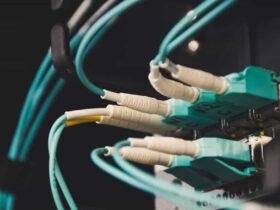Powerline adapters, a revolutionary technology in the realm of home networking, offer a unique solution by turning the existing electrical wiring of a house into a high-speed network. This article delves into the intricate workings of powerline adapters, exploring how they harness the electrical infrastructure to provide internet connectivity in areas where traditional Wi-Fi fails to reach. From their inception to the latest technological advancements, we will uncover the principles behind this innovative approach to networking, its advantages, limitations, and increasing relevance in our ever-connected world. This introduction sets the stage for a detailed exploration of a technology that seamlessly blends electrical engineering and digital communication, offering a glimpse into the future of home networking.
How Do Powerline Adapters Work?
Powerline adapters transmit internet data through the existing electrical wiring in a home or building, turning every electrical outlet into a potential network connection point. This technology is beneficial when Wi-Fi coverage is weak or running traditional Ethernet cables is impractical. Here’s a breakdown of how they work:
Conversion Of Data Signals: Powerline adapters work in pairs or more. One adapter is connected to your router and an electrical outlet. This adapter converts the data signal from the router into a signal that can travel over the electrical wiring.
Transmission Over Electrical Wiring: The converted signal is sent through the electrical circuit. Unlike the standard electrical current, which operates at 50-60 Hz, powerline networking signals operate at higher frequencies (typically 2 to 86 MHz), allowing the data signal to coexist with the regular electrical current without interference.
Reception And Reconversion: A second adapter is plugged into another outlet in the building where network connectivity is needed. This adapter receives the signal and converts it back into a standard Ethernet or Wi-Fi signal, which devices like computers, smart TVs, or game consoles can use.
Encryption For Security: To ensure security, powerline adapters often use encryption. This means the data transmitted over your electrical wiring is protected, making it difficult for unauthorized users to access your network.
Compatibility With Electrical Systems: Powerline adapters are designed to work with the standard electrical systems found in homes and offices. They don’t require special wiring or configuration, making them a convenient plug-and-play solution.
Network Extension And Flexibility: Powerline adapters can effectively extend your network to areas that are out of reach of your Wi-Fi router or where walls and floors obstruct wireless signals.
Basic Principles Of Powerline Adapters
The basic principles of Powerline adapters revolve around using the existing electrical wiring in a building as a medium for data transmission. This innovative approach provides an alternative to traditional Wi-Fi or Ethernet connections, particularly useful in areas where these standard methods are inefficient or impractical. Here’s an overview of the fundamental principles that govern Powerline technology:
Use Of Electrical Wiring For Data Transmission:
Powerline adapters utilize the electrical wiring in a building as a network cable. This is possible because electrical wires can carry more than just power. They can also carry data signals without significant interference with the electrical current.
Modulation Techniques:
Adapters use a modulation technique to transmit data over power lines that encode data into a carrier wave at a frequency different from the 50/60 Hz electrical current. Common modulation standards used in Powerline technology include OFDM (Orthogonal Frequency-Division Multiplexing).
Signal Transmission And Reception:
The process starts when one Powerline adapter is connected to a router and plugged into an electrical outlet. This adapter modulates the internet data into a signal compatible with the electrical wiring. This signal is then transmitted across the electrical circuit. A second Powerline adapter, plugged into another outlet, receives this signal and demodulates it, converting it into usable data for internet-enabled devices.
Network Creation And Extension:
Multiple Powerline adapters can create or extend a network. They can connect various devices across different rooms or floors, overcoming limitations like thick walls or long distances that often hinder Wi-Fi signals.
Encryption And Network Security:
Modern Powerline adapters employ encryption (such as 128-bit AES) to secure the data transmitted over the power lines. This encryption ensures that the network remains safe from external intrusions, maintaining the privacy and security of the data.
Compatibility And Coexistence With Electrical Systems:
Powerline technology is designed to be compatible with standard electrical systems, requiring no additional wiring or complex installation processes. The adapters are engineered to coexist with the electrical current without causing interference or disruption to the electrical system or the data signal.
Quality Of Service (QoS) And Management:
Some Powerline adapters come with built-in QoS features, prioritizing traffic to ensure smoother streaming of high-bandwidth applications like video conferencing or online gaming.
Plug-And-Play Functionality:
Powerline adapters are generally easy to set up, offering a plug-and-play solution where users simply plug the adapters into the outlets and connect one to the router, and the system is ready to use.
Components And Functioning Of Powerline Adapters
Powerline adapters are comprised of several key components that work together to enable data transmission over electrical wiring. Understanding these components’ functioning is crucial to comprehending how Powerline technology operates. Here’s a breakdown of the main components and their roles:
- Power Plug And Electrical Interface: The most visible part of a Powerline adapter is the power plug, which allows it to be directly plugged into a standard electrical outlet. This interface connects the adapter to the building’s electrical wiring, enabling it to send and receive data signals through the power lines.
- Ethernet Ports: Most Powerline adapters have one or more Ethernet ports. These ports connect the adapter to a router (for the adapter near your internet source) and wired devices (like computers, smart TVs, or gaming consoles) for the adapter at the destination.
- Modem Or Modulation Circuitry: This component is crucial for converting digital data into a signal that can be transmitted over power lines. It uses modulation techniques, typically Orthogonal Frequency-Division Multiplexing (OFDM), to encode the data onto a carrier wave that can travel alongside the electrical current without interference.
- Signal Processor: The signal processor handles the task of encoding and decoding the data signals. It modulates the data signal for transmission and then demodulates received signals back into digital data that devices can understand.
- Powerline Communication (PLC) Chipset: This chipset is the heart of a Powerline adapter. It manages the sending and receiving data packets over the electrical wiring, ensuring efficient and reliable data transmission.
- Encryption And Security Features: For security, modern Powerline adapters incorporate encryption technologies, such as 128-bit AES encryption. This feature protects the data traveling over the electrical wiring from unauthorized access.
- Firmware And Software: The firmware and software within Powerline adapters enable features like network management, quality of service (QoS) controls, and configuration settings. They also ensure compatibility with different network protocols and standards.
- Filtering And Noise Suppression Circuits: These circuits help minimize interference from other electrical devices and ensure that the Powerline signal remains solid and stable.
Step-By-Step Guide On Setting Up Powerline Adapters
Setting up Powerline adapters is a straightforward process that requires minimal technical expertise. Here’s a step-by-step guide to help you get started:
First, select a Powerline adapter kit that suits your needs. Most kits come with two adapters, but additional adapters can be used for extending the network to other rooms. Begin by plugging one of the Powerline adapters into an electrical outlet near your router. It’s important to plug the adapter directly into the wall rather than a power strip or surge protector, as these can interfere with the signal.
Next, connect this first adapter to your router using an Ethernet cable. Typically, one end of the cable goes into the Ethernet port on the adapter, and the other end plugs into a free Ethernet port on your router. Now, take the second Powerline adapter to where you want to extend your network. Plug this adapter into an electrical outlet in the desired area. It’s best to plug it directly into the wall like the first adapter.
Once both adapters are plugged in, they should automatically pair. Most Powerline adapters have a pairing button to press for a more secure connection. Consult your adapter’s manual for specific pairing instructions. After the adapters are paired, you can connect a device to the second adapter. Use another Ethernet cable to connect the device to the adapter. You can connect devices wirelessly if your Powerline adapter also provides a Wi-Fi signal.
Finally, check the connectivity and speed. Powerline adapters typically have LED indicators showing the connection status and signal strength. If the connection is not working as expected, try plugging the second adapter into a different outlet closer to the first adapter. For optimal performance, it’s advised to keep the adapters on the same electrical circuit and avoid plugging them into outlets with high-power appliances, as these can cause interference.
With these steps completed, your Powerline network should be up and running. You can now enjoy internet connectivity in your home or office areas where Wi-Fi signals were previously weak or nonexistent. Remember, the performance of Powerline adapters can depend on the quality and layout of your electrical wiring. Consulting the user manual or seeking technical support may be helpful if you encounter issues.
Final Words
Powerline adapters present an innovative and practical solution for extending network connectivity within a home or office, utilizing the existing electrical wiring to overcome limitations posed by traditional Wi-Fi or Ethernet-based systems. Their ease of installation, coupled with the ability to provide stable and secure internet connectivity in areas otherwise difficult to reach, makes them a valuable tool in today’s increasingly connected world. As we’ve explored, while Powerline technology is influenced by factors like the quality of electrical wiring and the layout of the premises, its benefits, including plug-and-play simplicity, encryption security, and compliance with safety and regulatory standards, make it a compelling choice for many users. Powerline adapters offer a robust solution, Whether for streaming media in a remote part of the house, connecting a home office, or supporting smart home devices.

























Leave a Reply